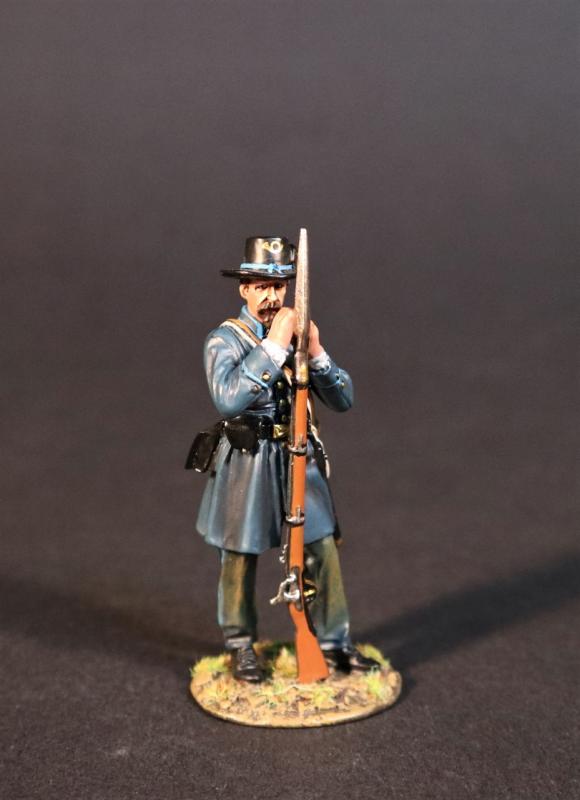Infantry Standing (both hands leaning on barrel), Co. L, West Augusta Guards, Staunton, 5th Virginia Regiment, The Army of the Shenandoah, The First Battle of Manassas, 1861, ACW 1861-1865--single figure
$43.00
Item Number: CS5V-04
Infantry Standing (both hands leaning on barrel), Co. L, West Augusta Guards, Staunton, 5th Virginia Regiment, The Army of the Shenandoah, The First Battle of Manassas, 1861, ACW 1861-1865
The 5th Virginia Infantry Regiment was an infantry regiment raised in Virginia for service in the Confederate States Army during the American Civil War. It fought in the “Stonewall Brigade”, mostly with the army of Northern Virginia. The Regiment was known as the “Fighting Fifth”.
The 5th Virginia Infantry Regiment was organized in May 1861 under Colonel Kenton Harper. Eight Companies were from Augusta County and two were from Frederick County. Civil War regiments were usually made up of ten companies of about 50 men, each of which was designated by a letter between A and K (J not used). A regiment would be commanded by a Colonel and Lieutenant Colonel, and companies by captains.
Colonel Kenton Harper, was given command of the 5th Virginia Infantry regiment on May 7th 1861. Harper and the 5th Virginia fought well during the First Battle of Bull Run on July 21st 1861, “where his soldierly ability attracted the notice of the army commander”. Harper was to resign from the Confederate Army on September 11th, because Jackson refused to allow Harper permission to return home where his wife lay dying.
Organized at Staunton in the Shenandoah Valley in 1858, the West Augusta Guard were nicknamed the “Wags”, and wore a version of the state regulation uniform adapted during the same year. It consisted of a dark blue frock coat cut after U.S. regulation pattern and fastened with gilt buttons bearing the Virginia state seal. Collar and cuffs were edged with sky blue piping. Trousers were also dark blue with sky blue seam stripes. Hardee hats had a yellow metal bugle insignia on the front, with the brim looped up on the left by a brass eagle device, and also a sky-blue worsted hat cord and tassle. There was a single black ostrich feather normally attached to the right side of the crown, but it is believed these were removed at First Bull Run because they believed that the “Yankees” wore the same.
Captain William S. H. Baylor was the Company Commander, and later became the Colonel of the Regiment.
The ranks of these new companies were filled quickly and came from a variety of backgrounds and occupations, and ranging in age from teenagers to old timers. Most of them were either English or Scots-Irish by descent, with a good smattering of Irish, German and Swedish. Due to the local recruitment from the Shenendoah, there was a widespread family element in the brigade, many brothers and cousins, and even father and sons, joining up together. One company in the 5th Virginia listed 18 different members of a family called Bell (only 7 of whom survived the war).
About a third of the men were farmers, the area being predominantly agricultural. Most had grown up familiar with firearms, either for defence or to provide meat for the table. But it has also been said that the Valley’s volunteers made up the most highly educated brigade in the civil war. This was due to the fact that the Shenendoah was prosperous, and many of the men had attended nearby Washington College, the Virginia Military Institute (VMI) in Lexington, or the University of Virginia in Charlottesville.
General Joseph Johnston once commented that Jackson was “most fortunate in commanding the flower of the Virginia troops.”
Due to be released in JUNE 2022.
